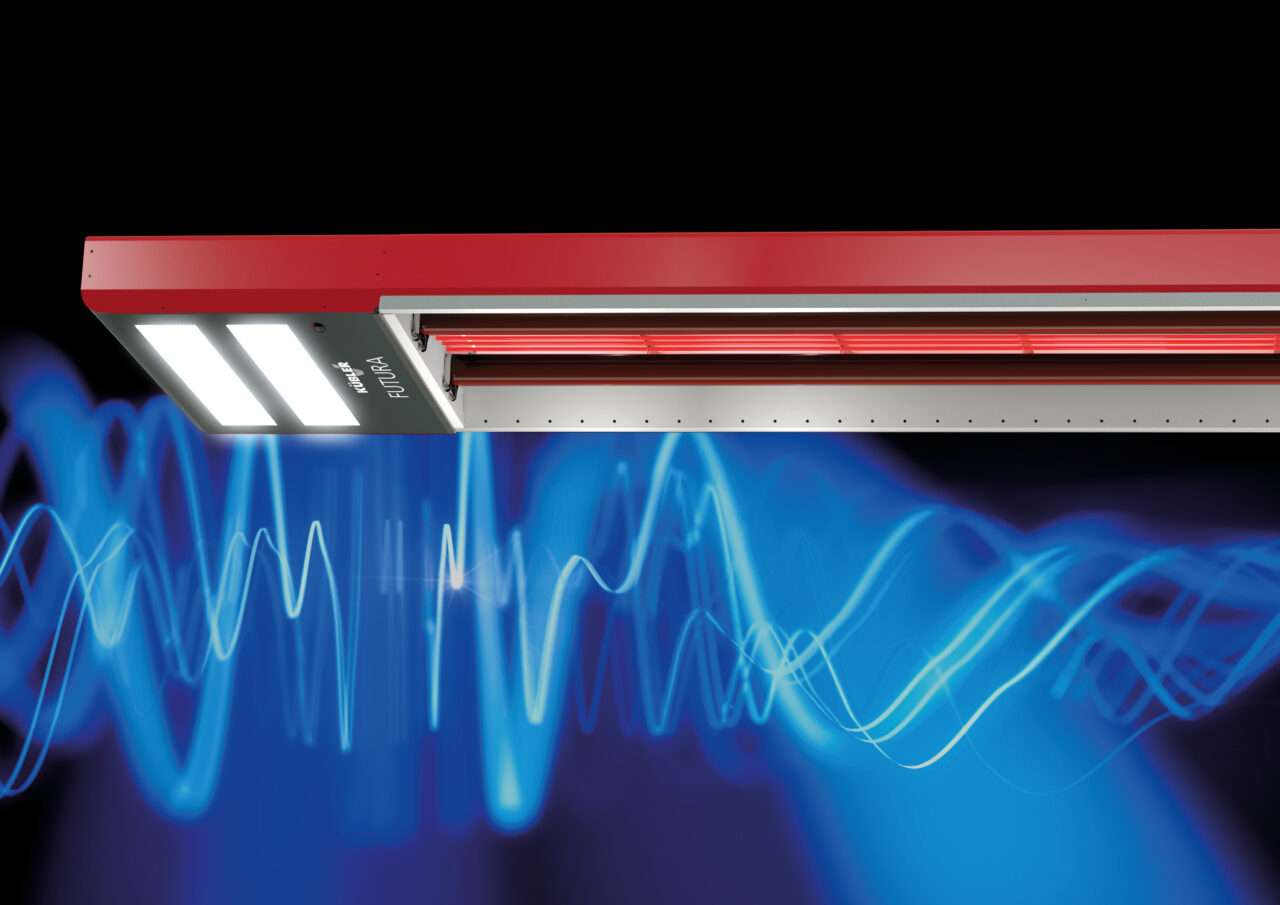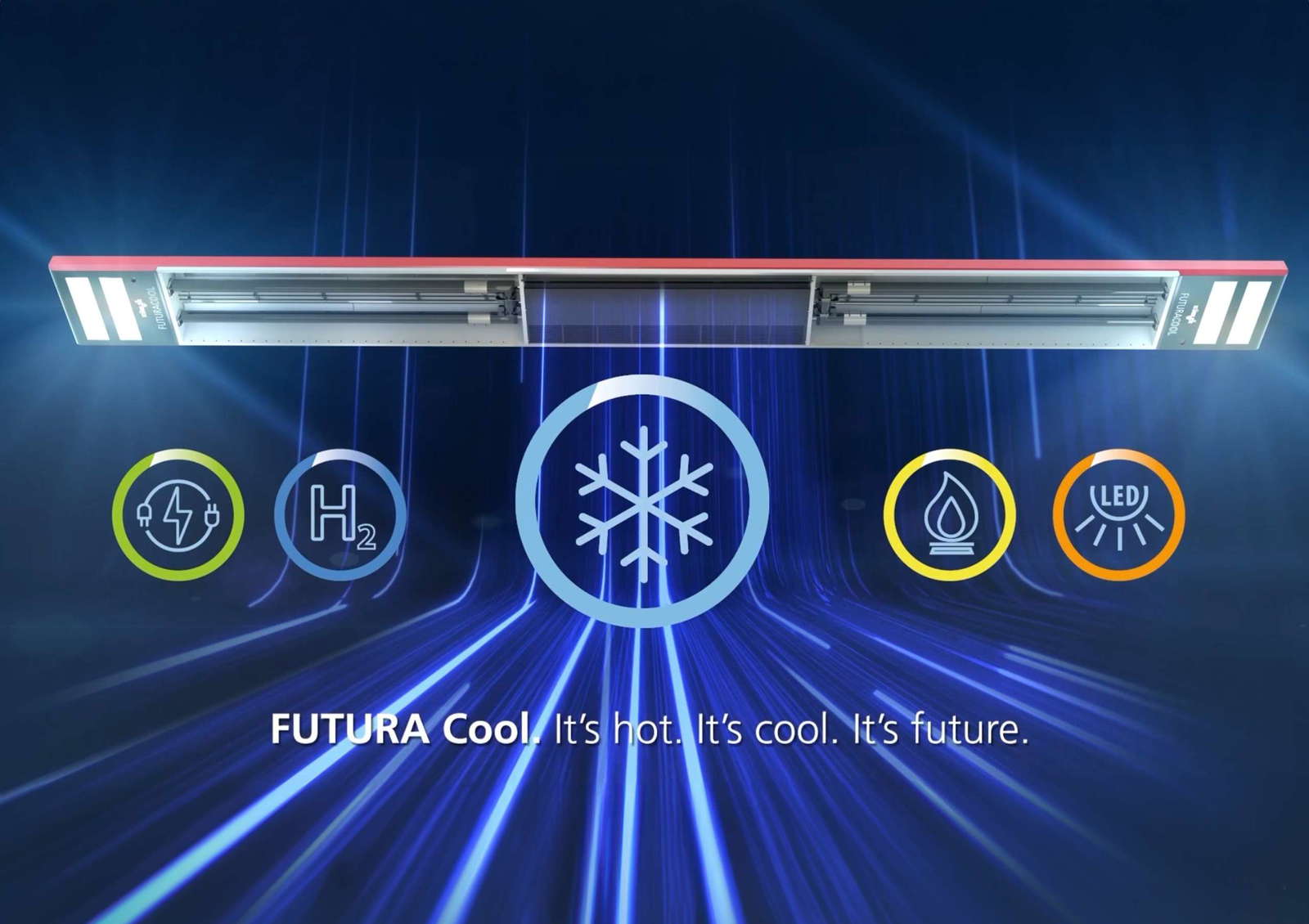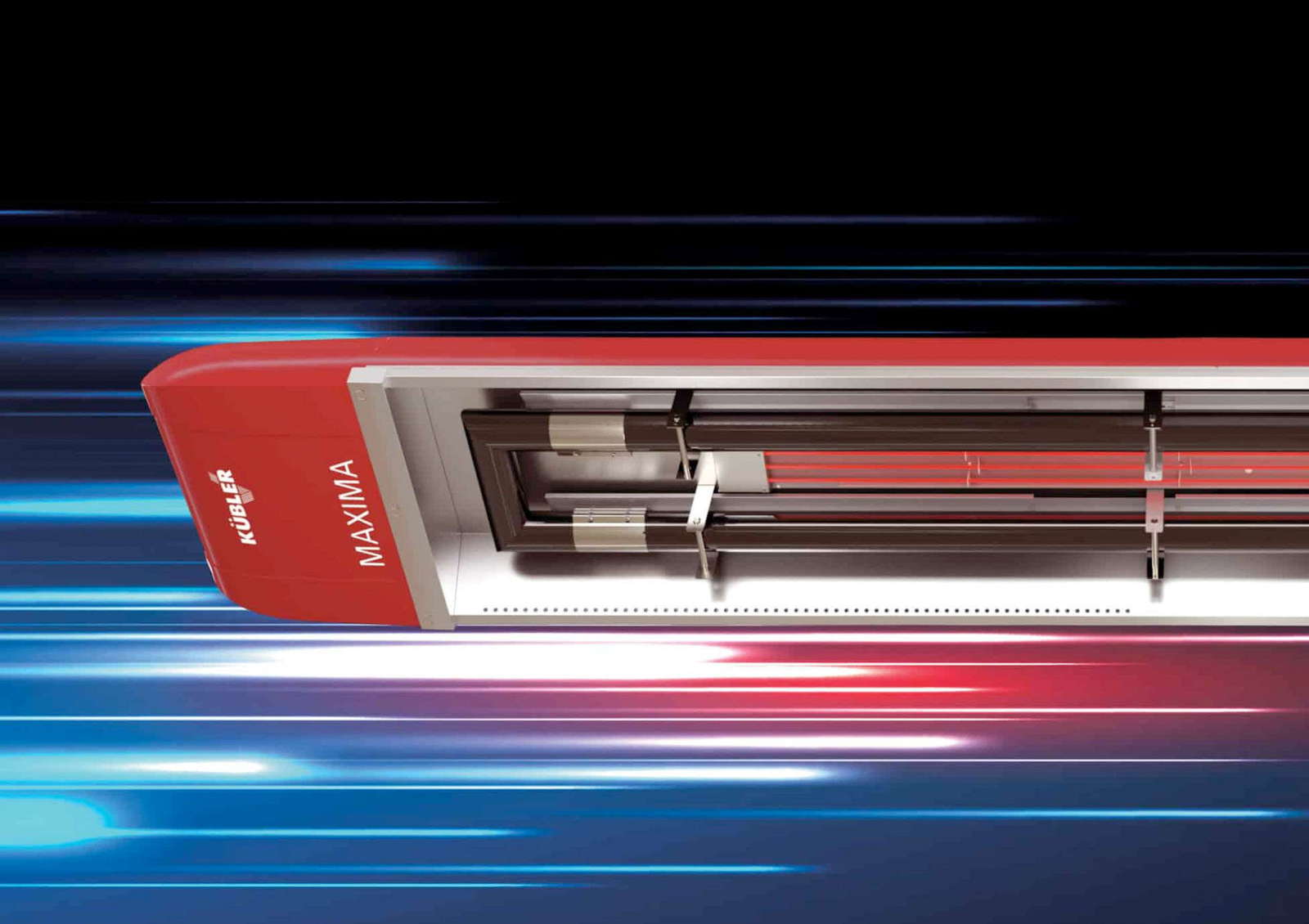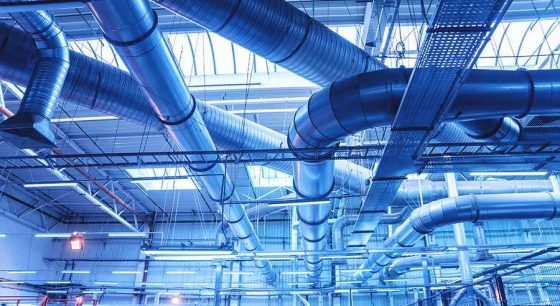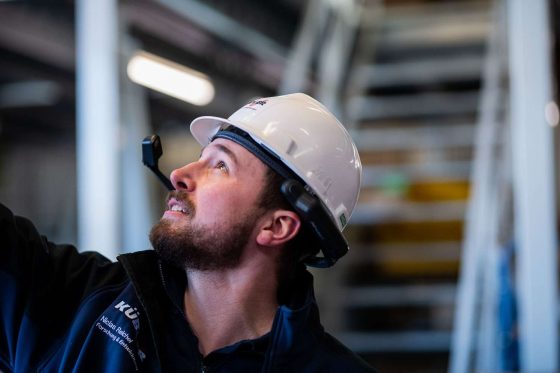Radiant heating - function, types and possible applications
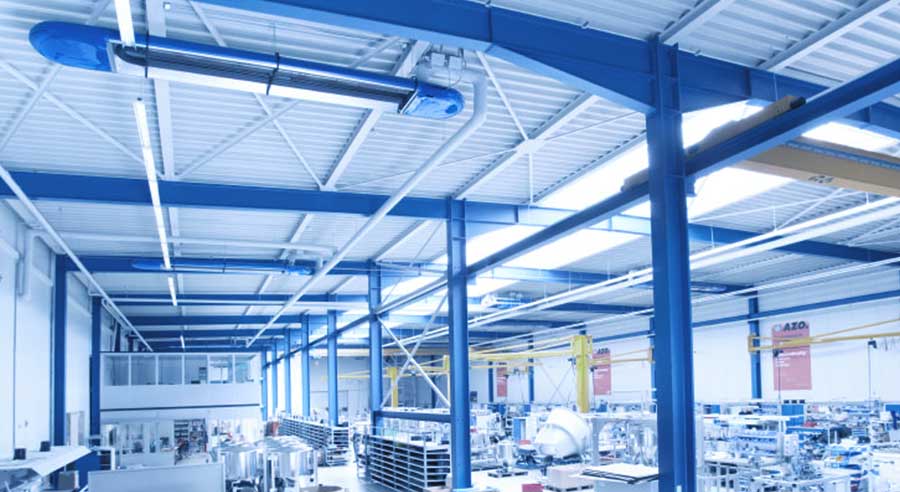
But how do radiant heaters actually work? And what types are there? Read all about radiant heating systems and why they are the ideal choice for industrial and event halls in our article.
Radiant heaters - the difference between light and dark radiators
Heating systems as we know them from our private environment work with water, which is heated at a central point, flows through the radiator and thus heats the room. Radiant heating systems, on the other hand, do not require a transfer medium such as water, which is heated centrally, but instead generate heating energy directly in or on a radiating component, which projects the heat into the surroundings. There are two different types of radiant heaters: Bright radiators and dark radiators. Both variants are similar, but have a different mode of operation.
Characteristics of high bay heaters
In radiant heaters, which are bright radiators, a fuel gas mixed with the combustion air burns on a high-temperature-resistant, perforated ceramic plate. The burner surface heats up to temperatures between 750 °C and 950 °C in the process. The plate of the radiant heater glows visibly, which gives the heater its name, and emits infrared radiation into the environment. As soon as the radiation hits solid bodies, it is converted into heat. The exhaust gases produced by this open combustion are usually released into the open air with the room air. It is therefore important to ensure adequate ventilation, for example with ceiling fans.
Characteristics of dark radiators
The second type of radiant heaters are so-called Dark radiator, which today are usually called infrared radiators. They are also among the decentralized hall heating systems that combine heat generation and heat transfer in one device. Although their physical principle is identical to that of bright radiators, they have a different mode of operation. Dark radiators do not work with open combustion, but with pipes, usually in a U-shape. A combustion gas, usually natural gas, flows through these tubes at a temperature of up to 800 °C - a suction fan at the end of the tube generates the negative pressure for transporting the combustion gas, which is burned by a burner. The average surface temperature of 250 °C to 500 °C is approximately the same along the entire length of the pipe. Finally, a reflector directs the infrared radiation from the pipes into the heating area so that the heat generated by the radiant heating is transferred to the surroundings.
Why the name dark radiator is outdated from a technical point of view
In contrast to bright radiators, the term dark radiators used to refer to a non-glowing heating surface in radiant heaters. Today, however, there are also devices with glowing tubes in the high-performance class of dark radiators. So why are they not classed as bright radiant heaters? Because they work with closed rather than open combustion. The name infrared radiator therefore seems more appropriate for this type of radiant heater. The great advantage of closed combustion is that users can discharge exhaust gases in a controlled manner via pipes. And, if desired, the residual heat can be transferred to a heat exchanger to heat offices, for example, via a classic hydraulic heating system.
A brief digression: it doesn't always have to be natural gas
Electric radiant heaters are a special form of radiant heating. They do not rely on the combustion of a fuel, but on a current flow in an electrical resistor. However, electric radiant heaters do not generally play a role in the heating of indoor buildings - they are more suitable for baby changing tables or the heating of benches and tables in beer gardens. Nevertheless, this is an exciting approach that will be further developed and expanded over the next few years to offer alternatives to radiant heating systems, such as dark and light radiators, as well as classic heating systems.
This is where radiant ceiling panels differ from other radiant heating systems
Radiant ceiling panels also work with thermal radiation - heating elements in the form of profiled strips made of sheet steel with welded-in pipes. Hot water flows through the pipes, heating the radiant surfaces so that they emit radiant heat. Radiant ceiling panels can also heat large halls. Due to their low temperature, radiant ceiling panels require very large areas on the ceilings and therefore a relatively large amount of space. In addition, hot water as an activator is a very inert medium. Temperature changes and adjustments of the heating operation to a dynamic daily routine can therefore not be realized as quickly as with gas-powered radiant heating systems.
Radiant heating - the optimal choice for industrial halls
Halls with ceiling heights of several meters have a gigantic volume and only a small part of around 20 percent is the usable area - usually 2.5 meters above the floor. The problem: with classic convection, it is difficult to heat this area in a targeted and efficient manner. This is because warm air does not stay in one place, but always rises upwards - to where nobody needs it. A physical principle that is incorruptible and causes hall operators a great deal of heat loss. In addition, warm air currents cause dust turbulence and unpleasant draughts in halls. With radiant heaters such as light or dark radiant heaters, this does not occur and targeted heat dissipation is ensured.
Aspects that speak for decentralized radiant heating systems
As already mentioned, radiant heating enables the targeted heating of the desired area of a hall. It is therefore pleasantly warm where people are working, while it remains cool in the upper layers of air. Even when gates and doors open and close frequently. Radiant heating systems are therefore not only absolutely efficient, but also save a great deal of energy.
The heat from radiant heating systems is also immediately available, as there is no need for a reaction-carrying detour via heat-conducting media such as water and air. This means that rooms that normally remain cold can also be heated efficiently for short periods of use. For example, storage rooms that employees rarely enter. As there are no draughts when heating with radiant heating, dust pollution is also reduced. This makes infrared systems ideal for allergy sufferers and a generally more pleasant and healthier indoor atmosphere.
Save up to 70 percent energy with radiant heating
However, radiant heating systems not only make it possible to heat cold rooms quickly and for a short time, they also allow operators to divide huge hall spaces into several heating zones. This means that they do not have to set a standard temperature, but can, for example, set different temperatures near the Waste heat of machines and systems, but more in the storage area. In this way, radiant heating provides all employees with the perfect feel-good temperature - without wasting any energy.
If users also network the radiant heaters with intelligent control systems and analysis software, they can continuously monitor and optimize all heating operation parameters. The bottom line is enormous cost savings. Compared to conventional convection systems, hall operators generally save between 30 and 50 percent energy with these radiant heating systems, and up to 70 percent depending on the project.
A small example: St. Pauli fish auction hall saves around 50 percent on energy costs with radiant heating
However, radiant heating systems are not only used in industrial halls. Word of their advantages has long since spread in the event industry. You can find the Heating systems now also at concerts, art exhibitions and Company eventswhich take place in unusual locations - such as old fish factories or heating plants.
For example, in the old fish auction hall on the St. Pauli fish market. Radiant heating systems from KÜBLER provide pleasant warmth on the stage as well as at tables, benches and food stands in the 103-metre-long and 23-metre-wide hall, which is eleven meters high at the dome. The cubic meters of air above the usage area, on the other hand, remain cool. Without disturbing anyone. On the contrary: the operators save up to 50 percent in energy costs compared to conventional warm air heating systems.
-
Only around half of German companies are aware of their waste heat potential - this is what dena writes in its publication on waste heat utilization as part of the Energy Efficiency Initiative. This means that an estimated 226 TWh of usable heat goes unused every year. That is 36 % of the energy used by the entire manufacturing industry. Clearly, this costs companies an enormous amount of money, but at the same time the unused waste heat has a negative impact on the environment. Around 60 million tons of the greenhouse gas CO2 are unnecessarily evaporated into the atmosphere every year. In view of rising energy costs and climate protection targets, companies simply can no longer afford to do this.
-
What is probably the most effective lever against the gas crisis, price pressure and dependence on Russia at the moment? The answer: consuming less energy. The German government is of this opinion and is calling for energy savings in a large-scale campaign - supported by industry and associations. This goal can be achieved. When it comes to the large halls of industrial and commercial enterprises, it is even easier and quicker than expected.
-
Nobody thinks about the hall heating when the sun is blazing, the asphalt is glowing and everyone is grateful for the slightest cooling. Or do they? Because anyone who looks ahead knows that summertime is maintenance time. So if you want to start the winter safely with your production halls or warehouses, it's good to be prepared. After all, the next heating period is often around the corner sooner than you think, which raises the question: is your hall heating system fit for the next season?
-
It is only a small segment, but of great importance: in the current discussion about the energy transition, industrial buildings are being neglected. They only make up two percent of the building stock in Germany. However, they are responsible for around 15 percent of building-related energy consumption and the associated greenhouse gas (GHG) emissions. In the current Building Energy Act (GEG), however, industrial buildings are treated in the same way as daycare centers - and there are indications in a draft bill that the federal government wants to focus exclusively on heat pumps as a technology. KÜBLER GmbH in Ludwigshafen invited experts to discuss this issue. Daniel Föst, construction policy spokesman for the FDP parliamentary group in the Bundestag, announced his intention to change the legislative system.
